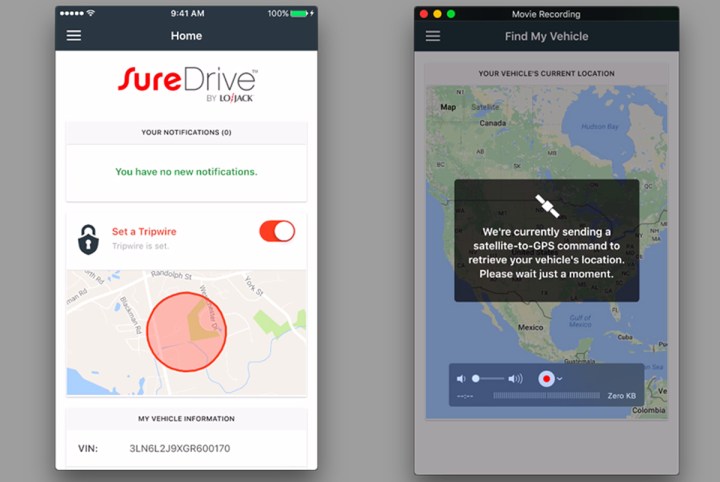
SureDrive is an on-car connected car security platform with features that offer to make consumers’ lives easier and more secure. SureDrive helps protect your vehicle from theft but has convenience applications families could grow to love.
The conventional LoJack system uses a radio signal transmitter than can be tracked by law enforcement when a car is reported stolen. SureDrive, however, is a consumer product based on a GPS system installed in your vehicle that is accessed, configured, and controlled with a smartphone app.
Tripwire Early Warning and Stolen Vehicle Assist are two of SureDrive’s headline features. With Tripwire you set a configurable security perimeter around your vehicle. If your vehicle moves outside that perimeter you are immediately alerted. If the car was stolen, you can contact law enforcement with one tap on your smartphone to let them know and provide information they can use to help find your car.
Perimeter configuration can be useful in several situations. For example, if you park your car in a lot where you know it may be moved by attendants or valets, then you wouldn’t want to be alerted, so you could set the perimeter wider but still tight enough that you don’t have a Ferris Beuller incident.
Instant Crash Notification (ICN) uses sensors and algorithms to detect crashes. If a crash occurs, an alert is sent to a monitoring agency that can call in emergency assistance if needed.
The SureDrive Real-Time Location feature, which CalAmp said will be the basis for added future capabilities, lets you track the exact location of your vehicle. A related feature called My Locations allows you to configure up to six locations for alerts. For example, you could include your home, your kids’ schools, and your office. Any time your vehicle enters or exits one of the configured locations, an alert is sent to whomever you choose. So you could have a text sent to your kids that you have just arrived at the school parking lot to pick them up.
SureDrive is a dealership option installed at the time of new car purchase. It’s a one-time expense, with no monthly fee. Down the road, CalAmp told Digital Trends, there might be a retrofit SureDrive product that dealers or aftermarket installers could put in cars.
SureDrive complements but does not replace the traditional and proven LoJack stolen vehicle recovery system (SVR). LoJack uses a small unmarked radio frequency transceiver activated after police notification of a theft. An optional LoJack Early Warning feature sends you email, text, or phone message if your vehicle is moved when you are not in the vicinity, but you don’t directly track your car or truck with LoJack.
LotSmart by LoJack is a related new product which uses the same GPS hardware as SureDrive. LotSmart provides car dealerships with a location-based inventory management tool for streamlining operations and protecting cars on the lots.
SureDrive by LoJack is slated for availability in early fall 2016.



